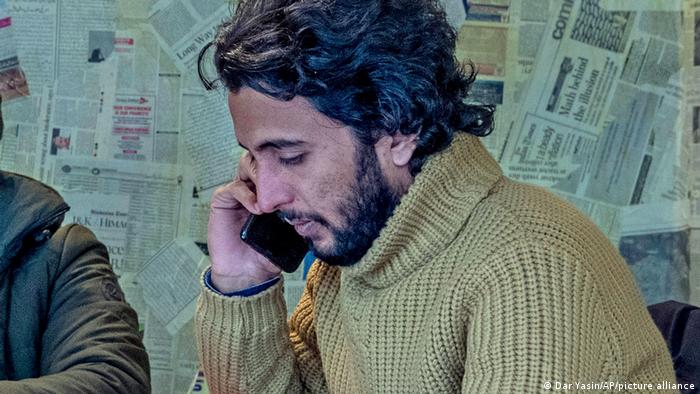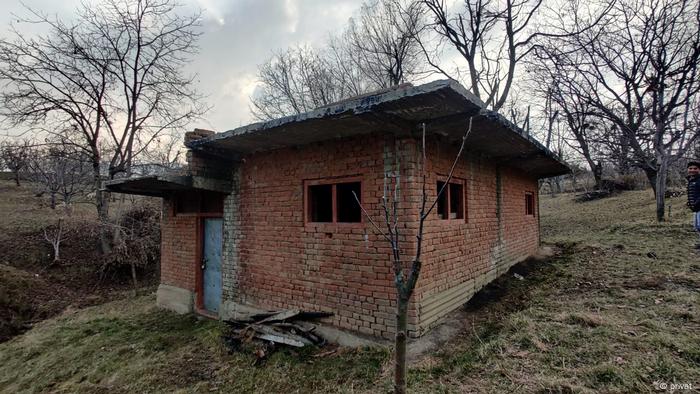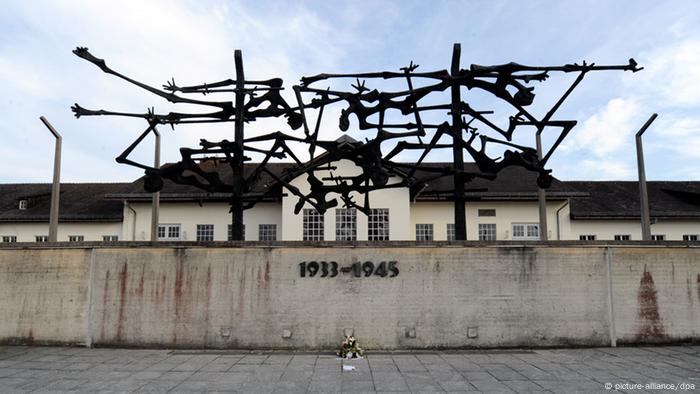Fahad Shah, the editor of news portal Kashmir Walla, has been accused of inciting violence and "glorifying terrorism" as Indian officials continue their media clampdown.

Fahad Shah has been accused of 'glorifying terrorism and spreading fake news'
Police in Indian-controlled Kashmir have arrested a prominent journalist accused of publishing "anti-national content" as part of a widening clampdown on media in the disputed region.
On Saturday, police tweeted that Fahad Shah was wanted in three cases of "glorifying terrorism, spreading fake news and inciting general public for creating L&O (law and order) situations."
Shah serves as the editor of news portal Kashmir Walla. He was questioned by authorities in southern Pulwama town on Friday and subsequently arrested.
Police said Shah was identified among users of Facebook and other online portals who had published content that had a "criminal intention" to spark fear and could "provoke the public to disturb law and order."
Watch video04:22 Is the media crackdown in Kashmir escalating?
Gunfight report linked to the arrest
Shah's arrest is believed to be connected to a gunfight inside a civilian house between Kashmiri rebels and Indian troops in Pulwama on January 30. Police had said a rebel commander was killed in the hostilities along with a Pakistani and another local militant. The fourth person killed was the house owner's teenage son. The authorities described the youth as a "hybrid" militant, a term police began use for alleged militants with no police record and who operate as civilians.
The Kashmir Walla website carried a series of reports on the gunfight presenting both sides. One video report quoted family members of the slain teenager refuting the police. Another piece of footage quoted the boy's sister which contradicted an earlier statement from the family.
In recent years Shah has come under increasing scrutiny over his reporting. He had already been questioned by police officers several times relating to his media work, long before Friday's arrest.
Shah's detention illustrated the "utter disregard" authorities have in the region "for press freedom and the fundamental right of journalists to report freely and safely," said the head of the Committee to Protect Journalists' (CPJ) Asia program, Steven Butler.
Dozens of journalists in Indian-controlled Kashmir have regularly been summoned by police and questioned for their work since 2019, when New Delhi revoked the territory's partial autonomy, bringing it under direct rule.
jsi/dj (AP, AFP)
Rights activists and family members of victims say the Indian army in Kashmir is using a legal loophole to get away with murder.

Human rights advocates say Indian troops can operate with 'impunity' in Kashmir
On a summer morning in 2020, 25-year-old Abrar Chouhan rose early to play with his son before leaving his village in Indian-administered Kashmir to work as a seasonal laborer in an apple orchard.
He knew that he wouldn't see his family for some time as he headed off to work with his brother-in-law.
"I told him not to leave me alone, but he wanted to earn money to complete construction of our house and to get our son into a good school," his wife, Shireen Akhter, told DW.
Little did she know, her husband would never return.
He was one of three men killed by the Indian army on July 17, 2020, in a remote cabin located on a hilltop covered in apple orchards outside the town of Shopian.
Following the incident, the Indian army released a statement claiming that it had killed three "Pakistani militants" who fired on them, and recovered pistols and other ammunition from them.
Based on pictures of their bodies, the men were identified as Chouhan, his 16-year-old brother-in-law, Abrar Khan, and another 21-year-old man named Imtiyaz Hussain.
Laborers killed to allegedly collect a bounty
The killings triggered protests and an investigation into why these men, who had no affiliation with Pakistani militants, were shot by Indian Army soldiers.
In December 2020, Jammu and Kashmir police determined that the killings were part of a scheme in which reward money and promotions are given out to army officers in exchange for targeting militants.

Shireen Akhter says her husband was killed by Indian army soldiers for a bounty
In some cases, civilians are falsely branded militants and killed to reap a reward from the Indian army.
In the orchard killings, two civilian "informers" and an Indian army officer are accused of staging the entire incident to collect a bounty equivalent to $27,000 (€23,000).
Police said army officer Captain Bhoopendra Singh "furnished false information to mislead senior officers into granting the reward, in furtherance of a criminal conspiracy."
Legal loophole complicates prosecution
In Kashmir, when local authorities need to investigate Indian army soldiers accused of human rights violations, they must first seek permission from New Delhi under the Armed Forces Special Powers Act (AFSPA).
For decades, the Indian military has been fighting Pakistan-backed insurgents in Kashmir. Islamabad says it provides only diplomatic support to Kashmiri insurgents.
According to an Indian army statement to DW, "Pakistan continues to be obsessed with Kashmir," and engages in a "vigorous proxy war in the Union Territory."
"Therefore, there is a requirement to conduct counter-terrorism operations to secure lives of the citizens," the statement read.
The Indian military also says the act is necessary to allow soldiers to respond to threats without fear of prosecution.
Critics argue that the AFSPA gives Indian armed forces wide powers to shoot to kill, carry out arrests on flimsy pretexts and conduct warrantless searches.
In the Shopian case, the army invoked the AFSPA to have the accused officer and two other army personnel involved stand trial by court martial.
"Initially, we had hope for justice. But, when the case was transferred to a military court, we realized that it will just be another number on a long list of killings in fabricated encounters by the Indian Army in Kashmir. There won’t be any justice," said Shireen Akhter.
Indian human rights activist Vrinda Grover told DW that the AFSPA has allowed the Indian military "unbridled power" in Kashmir for three decades.
"Indian soldiers have raped, tortured and killed people in Kashmir for in fake encounters without fear of being held accountable," she said.

Abrar Chouhan, his brother-in-law, and another man were shot dead in this cabin outside the town of Shopian
Indian army granted 'impunity' in Kashmir
Abdul Rashid Khan, 45, said his father and four other civilians were killed by the Indian army in a "fake encounter" 22 years ago.
The incident took place in southern Kashmir, and eight people were killed in protests that followed.
In 2007, public prosecutors indicted five army officers for killing the protesters. However, using the AFSPA, the army was able to bring the case to court-martial and the charges were subsequently dismissed.
"In a court-martial, the judge, jury and executor are the military, and the proceedings don't meet fair trial processes," Grover said, adding that the AFSPA, combined with court-martial proceedings, allows the military "absolute impunity" to violate human rights and is a continuing failure of the Indian justice system.
"These special laws for armed forces consolidate and entrench this impunity, making accountability impossible for egregious human rights abuses," Grover said.
Military says AFSPA is needed
Retired Indian Army General Ata Hasnain told DW that the act provides protection for soldiers operating in a hostile environment such as Kashmir, where mistakes can happen during operations.
For example, in February 2011, the army killed a young man in a case of mistaken identity.
"He was asked to stop at night, but he ran and got shot. He was innocent, but he flouted the rules of night curfew. Should the soldiers who shot him be prosecuted? Certainly not. They played by rules, he did not. Protection under AFSPA caters for such situations. Otherwise, soldiers will get prosecuted left, right and center," Hasnain said.
In a statement, the Indian army said it had "established a robust mechanism to ensure that all allegations of human rights violations are investigated" and the culprits, "if any, are punished."
The army statement also said there had been "a substantial decrease in the number of allegations of human rights violations against the army in the past few years."
Regarding the Shopian case, the statement said that the "Indian army has been proactive in investigations" and has taken "actions based on evidence, as has been the norm for all allegations and reported incidents in the past."
"In this case, the court-martial of the accused is presently underway, and due process of law will be followed to ensure justice," the statement said.
Lieutenant General DP Pandey, who commands the Indian army's Srinagar-based corps, recently told media that the AFSPA needs to be in force while the army is engaged in counterterrorism operations.
"I am sure the government will look at the revocation of AFSPA at a suitable time when the security situation improves," Pandey said.
Edited by: Wesley Rahn
DW RECOMMENDS
Why is India-administered Kashmir facing a power shortage?
Kashmir's subzero temperatures in winter and a dearth of electricity are a painful mixture for locals. With a vast capacity to produce hydropower, why is so little electricity available?
How will the Taliban takeover impact militancy in Kashmir?
India-administered Kashmir is reportedly seeing a surge in foreign militants. Analysts warn that increasing disaffection among young Kashmiris in the disputed region could have serious consequences.
India: At least 12 killed in stampede at religious shrine
Authorities say more than a dozen people were injured and subsequently hospitalized. An investigation has been launched into the cause of the stampede.





